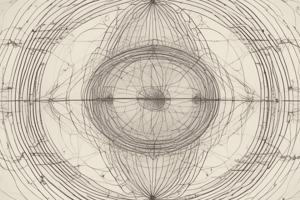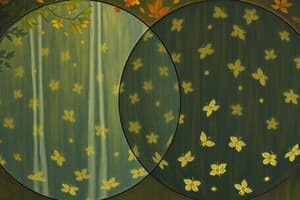Podcast
Questions and Answers
What is the definition of a subset?
What is the definition of a subset?
- A set that contains all elements of another set.
- A set that is equal to another set.
- A set whose elements are within another given set. (correct)
- A set with no elements.
How do you determine the total number of subsets of a given set with n elements?
How do you determine the total number of subsets of a given set with n elements?
- By using the formula $2^n$.
- By using the formula $2n - 1$. (correct)
- By multiplying n by itself.
- By using the formula $2^{n-1}$.
What is the characteristic of disjoint sets?
What is the characteristic of disjoint sets?
- They share some elements in common.
- They are subsets of a universal set.
- Their intersection contains no elements. (correct)
- They contain the same elements.
Which of these is an example of an infinite set?
Which of these is an example of an infinite set?
Which type of set contains no elements?
Which type of set contains no elements?
What is the definition of the union of two sets, X and Y?
What is the definition of the union of two sets, X and Y?
What is a characteristic of overlapping sets?
What is a characteristic of overlapping sets?
In a Venn diagram, which represents a universal set?
In a Venn diagram, which represents a universal set?
Flashcards
Subset
Subset
A set whose elements are all within another given set.
Subset Formula
Subset Formula
To find the total number of subsets, use 2n - 1, where n is the number of elements in the set.
Venn Diagram
Venn Diagram
A diagram that represents sets with overlapping circles.
Empty Set
Empty Set
Signup and view all the flashcards
Finite Set
Finite Set
Signup and view all the flashcards
Infinite Set
Infinite Set
Signup and view all the flashcards
Overlapping Sets
Overlapping Sets
Signup and view all the flashcards
Disjoint Sets
Disjoint Sets
Signup and view all the flashcards
Universal Set
Universal Set
Signup and view all the flashcards
Union of Sets
Union of Sets
Signup and view all the flashcards
Intersection of Sets
Intersection of Sets
Signup and view all the flashcards
Study Notes
Elementary Mathematics: Set Theory and Real Number System
- Subset: A set whose elements are all within another set.
- Example: If B = {1, 2} and A = {1, 2, 3, 4}, then B is a subset of A.
- Formula for total subsets: 2n - 1, where n is the number of elements in the set.
Venn Diagrams
- Definition: Diagrams that represent sets using circles.
- Example: A diagram showing the relationship between sets A, B, and C, likely overlapping.
Types of Sets
- Empty set: A set with no elements. Notation: {} or Ø.
- Example: The set of even prime numbers between 1 and 4
- Finite set: A set with a limited number of elements.
- Example: The set of the first two natural numbers
- Infinite set: A set with an unlimited number of elements.
- Example: The set of natural numbers
- Overlapping sets: Sets with at least one common element.
- Example: A = {2, 3, 5, 7} and B = {1, 2, 3, 4}
- Disjoint sets: Sets with no common elements.
- Example: A = {2, 3, 5, 7} and B = {4, 6, 8, 9}
- Universal set: A set containing all elements under consideration.
- Union of sets: The set containing all elements from both sets.
- Intersection of sets: The set containing only the common elements of both sets.
- Complement of a set: The set of elements that are not in the original set, but within the universal set.
- Difference of sets: The set of elements in one set that are not in the other.
Cardinality of a Set
- Definition: The number of elements in a given set.
- Example: If A = {2, 3, 5}, then n(A) = 3.
Studying That Suits You
Use AI to generate personalized quizzes and flashcards to suit your learning preferences.




